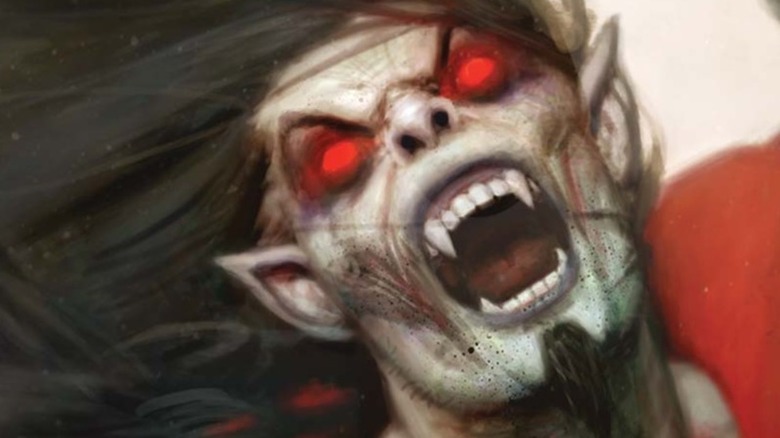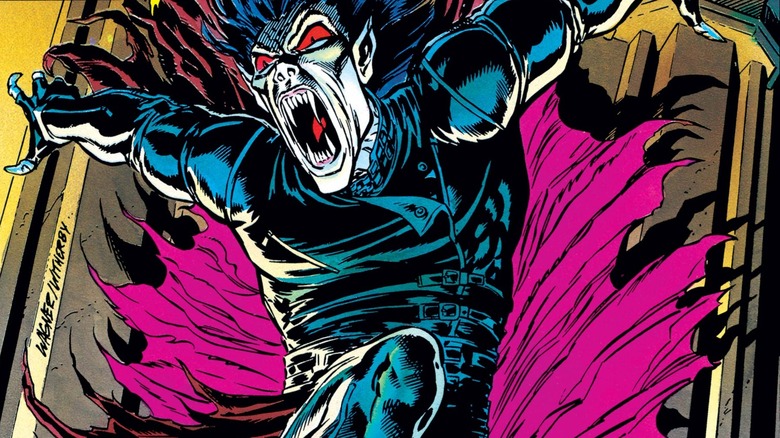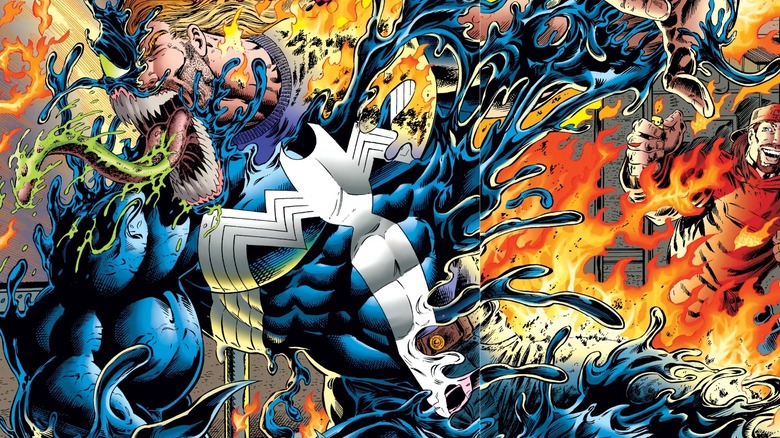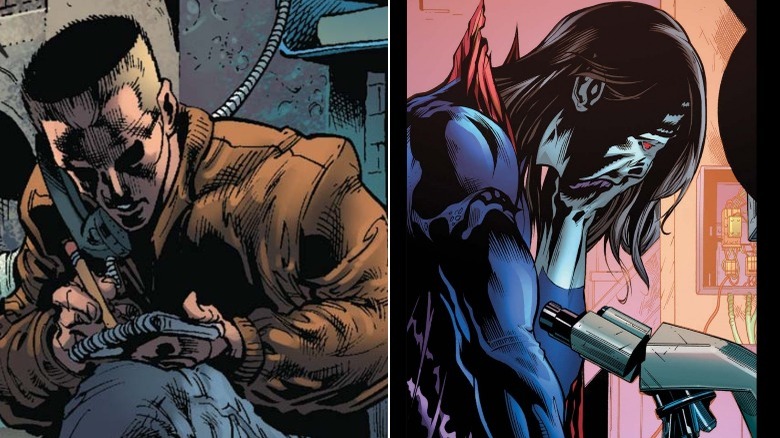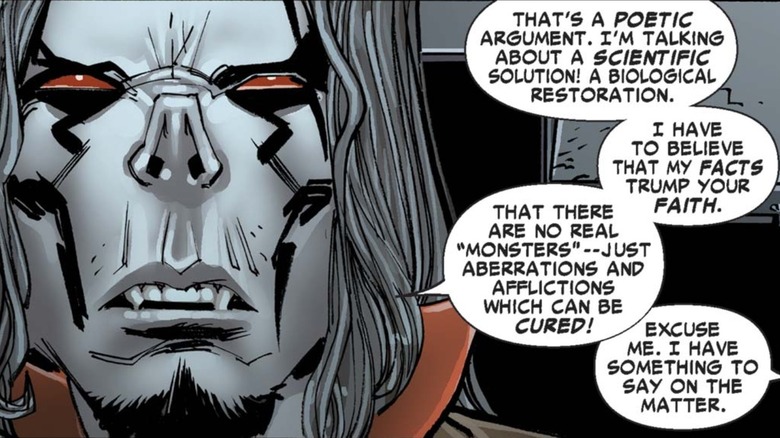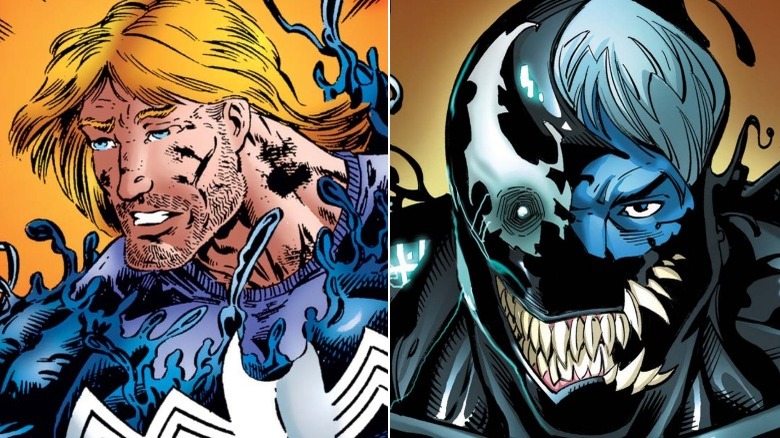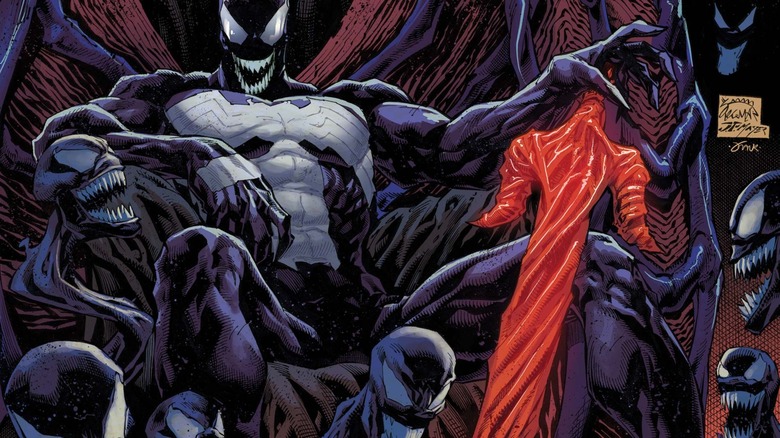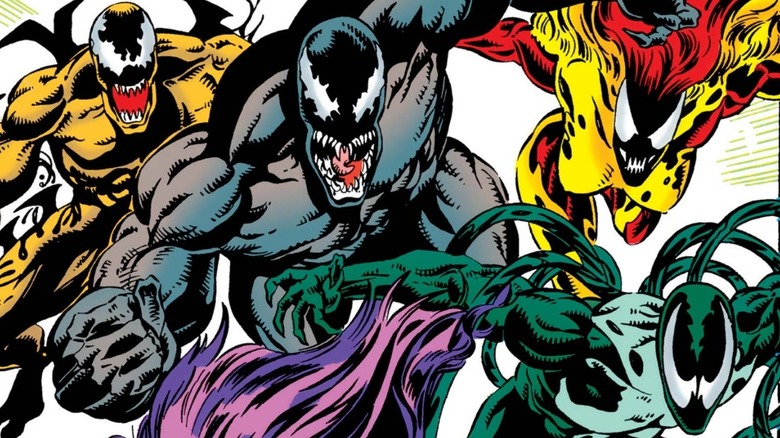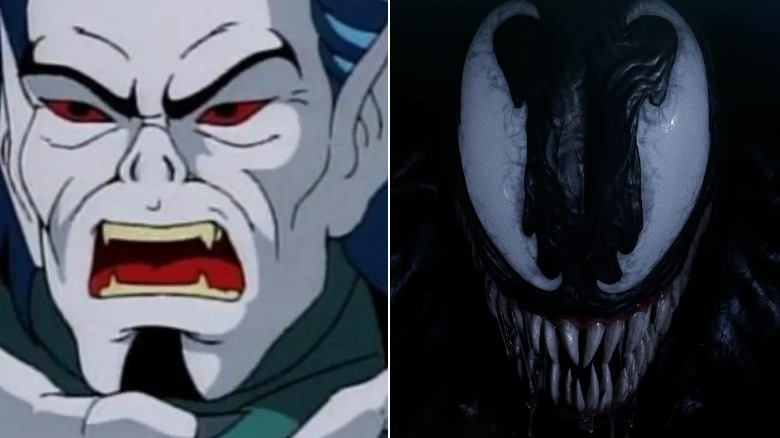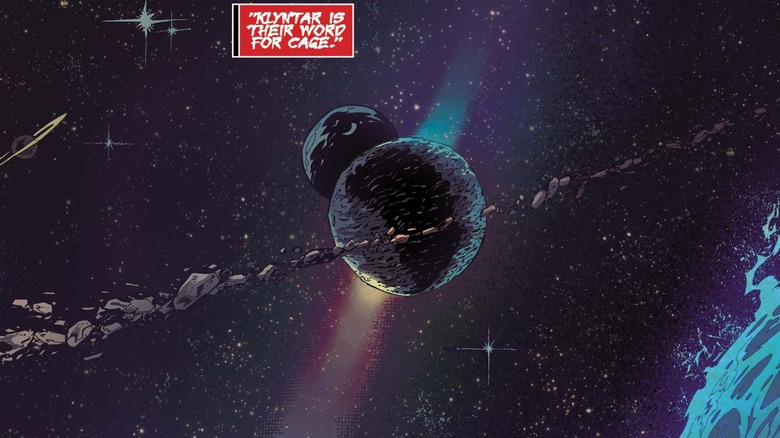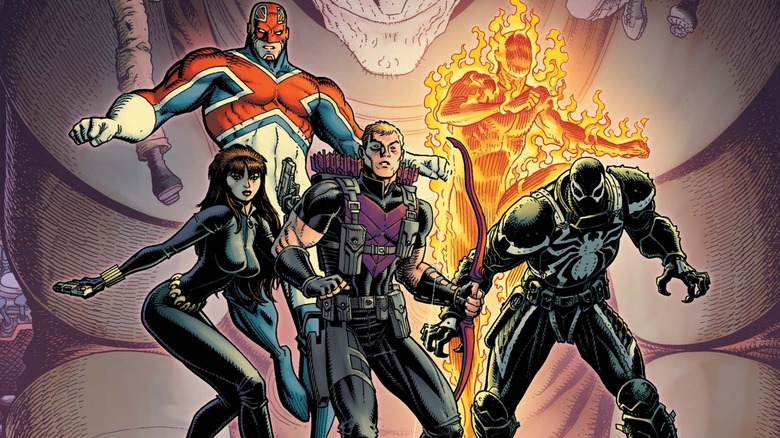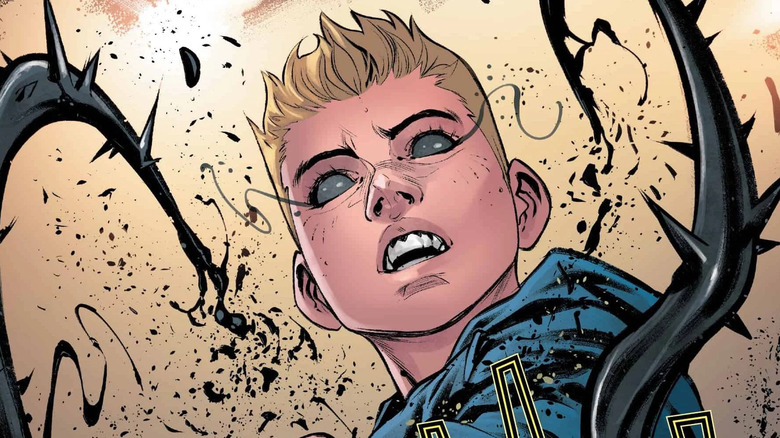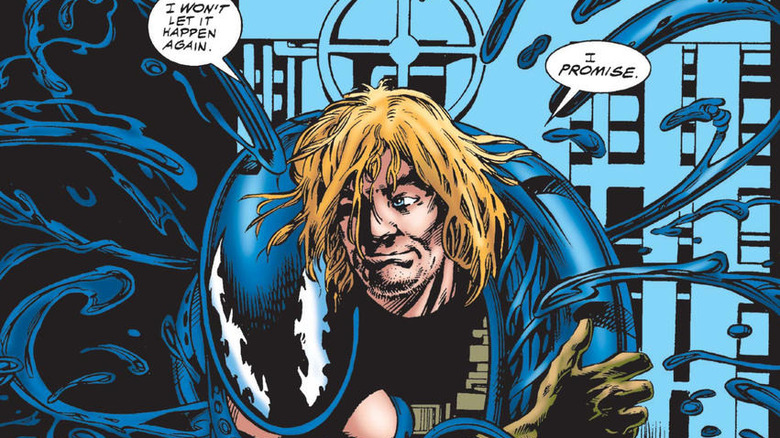The Biggest Differences Between Morbius And Venom Explained
You may not know it at first glance, but it's not hard to list the things Venom and Morbius have in common. They're both fanged Spider-Man villains who've fought on both sides of the law, and they both have some unusual appetites: Morbius, being a living vampire, struggles with the desire to consume blood, while Venom sometimes gets a mean hankering for consuming humans in general. They're both villains who've graced cinema screens in their own solo features, proving that giving Spider-Man a hard time isn't necessarily an obstacle when it comes to headlining movies ... although they've also teamed up with the Wallcrawler (and even each other) on a number of occasions. They've even both acted as guardians to underground societies — well, several, in Morbius' case.
Despite all this, however, there's a lot setting these two apart from each other, as well. Sharpen those fangs and wipe that green drool off your lip as we explore just what makes Morbius and Venom so different.
Their powers
Venom and Morbius are both stronger, faster, and more durable than most humans. Yet Venom significantly exceeds Morbius in all these categories, save perhaps the living vampire's healing powers, which allow Morbius to recover from injuries like shotgun wounds in an uncannily short period. Even then, Venom's healing abilities are comparable, though they usually don't have to deal with bullets, which are typically "caught" and expelled by the symbiote.
Otherwise, their powers are quite different. The Venom symbiote can reshape itself into anything from street clothes to weapons, turn its host invisible and conceal itself from Spider-Man's spider sense, and has inherited Peter Parker's webslinging and wallcrawling abilities. Morbius, meanwhile, gains nourishment and enhanced strength by consuming blood, and his bite sometimes turn others into vampires. Morbius' bones, being lightweight and hollow, make flying a breeze, although he (usually) can't fly without the artificial wings of his traditional costume. Because Morbius became a vampire through scientific means, neither garlic, holy water, nor objects of faith can hurt him, although he also lacks the shape-shifting powers of traditional vampires, which means no turning into bats for him.
The sources of their powers also differs. Venom's powers usually come from the alien symbiote that attaches itself to a host, while Morbius' abilities originated in an experiment in which he imbued his body with electricity and bat genetic material. As a result, Morbius cannot be "separated" from his powers, like Venom can, as they do not stem from a detachable organism.
Their weaknesses
Despite being immune to many of the weaknesses of normal vampires, Morbius isn't completely safe from the kinds of things that give his supernatural brethren a headache. Sunlight maybe not be immediately lethal to him, for instance, but he is allergic to it, meaning it causes him great discomfort and can severely affect him if he's exposed to it for too many days. Similarly, his reflection can be seen on reflective surfaces, robbing him of the kind of subterfuge supernatural vampires enjoy (as does Venom, who can turn invisible). What's more, sharp metal objects and stakes through the heart are as likely to kill Morbius as they would any normal human — he's only slightly more durable than we are, especially when he hasn't feasted for a while.
Normal sunlight may not hurt Venom, but that doesn't mean the symbiote is heat-friendly, as fire is one of its major weaknesses. Venom is also extremely sensitive to sonic vibrations, including at levels that wouldn't really hurt Morbius, like the gong of a large bell. In small quantities, neither weakness would necessarily kill the symbiote, but they can cause it to separate from its host, robbing that individual of the protection from harm that the symbiote provides.
Their professions
Alien symbiotes in the Marvel Universe aren't really known for having LinkedIn pages, but Venom's hosts have had a number of professions. The alien Tel-Kar, the Venom symbiote's first host, is a Kree soldier, while humans Lee Price and famed Spider-Man character Eugene "Flash" Thompson both served in the U.S. Army before becoming the symbiote's "other." Meanwhile, the most famous Venom host, Eddie Brock, is a journalist who dooms his reporting career when he takes Emil Gregg's erroneous claims of being the villainous Sin-Eater at face value. The fallout that ensues when Spider-Man apprehends the real Sin-Eater is what sets Brock down the road to becoming Venom.
Michael Morbius, meanwhile, seeks truth of a different sort as a biochemist and hematologist. Unlike Brock, though, Morbius is actually good at his job — brilliant, in fact, having won a Nobel Prize for his work and the attention of notable scientific minds like Mr. Fantastic, Curt Connors, and Stephen Strange. Morbius has used his talents to aid the super-human community, saving the Punisher's life during the "Frankencastle" storyline and stopping Jennifer Walters' cells from breaking down in "Savage She-Hulk" #12. Morbius even manages to cure himself of his bloodlust and vampirism for a number of years (while a stray lightning bolt undoes his vampirism in "Peter Parker: The Spectacular Spider-Man" #38). But as "Doctor Strange, Sorcerer Supreme" #12 reveals, all it takes is another powerful electric shock — this time against Morbius' will — to make the good doctor a living vampire again.
One of them has been historically nicer than the other
Since his introduction, Michael Morbius has been generally portrayed as a tortured soul. At his most starved, Morbius struggles to remember his humanity and sense of ethics and often behaves nefariously, but his human side constantly fights to keep his vampiric tendencies at bay. Furthermore, unlike Venom, Michael has never had delusions regarding the wrongfulness of his actions when not in control. That said, he can at times be condescending even in his better moments, and he's not always above manipulating others when trying to cure himself, as seen when he uses the Moon Stone to force John Jameson into doing his bidding as the Man-Wolf in "Giant-Size Super-Heroes Featuring Spider-Man" #1. Morbius also sometimes make poor decisions to help others, such as in "Spider-Man Family" #5, in which he uses the Vaal Talisman to steal Doctor Strange's powers so he can attempt to cure a close friend of Lou Gehrig's disease.
Venom, on the other hand, is more morally complicated. The symbiote tends to adapt to the morality of the host, but it can also warp their values. This is most evident in Eddie Brock, who in his early days as Venom is determined to kill Spider-Man, yet otherwise behaves in ways that are broadly heroic. Still, Brock clearly revels in cruelty as Venom in those days (though he later reforms), as does Mac Gargan, the Scorpion, when he becomes the host.
Venom can be different people
While Eddie Brock is the definitive Venom for many, the fact of the matter is that Venom can be just about anyone. Earth alone is full of characters who've either become Venom or spent time bonded to the symbiote, including Peter Parker, Eddie Brock, Anne Weying (Eddie's ex-wife), Angelo Fortunato, Mac Gargan, Flash Thompson, Lee Price, and Eddie and Anne's son, Dylan. Each of these characters, as well as Venom's extraterrestrial hosts like Tel-Kar, has interacted with the symbiote in their own unique way, with the alien often adapting its form to better reflect its host.
Conversely, there's only one Morbius ... likely to the character's relief. While his bite can convert others to living vampires like himself, rarely anyone who Morbius has turned has ever fully had the same metamorphosis. While they grow fangs and gain a lust for blood, their skin complexion does not become unnaturally white like Morbius', nor do they gain his red eyes. Most notably, however, they lack the immunity Morbius has to the radiation within his blood, making their bodies vulnerable to disintegration should they take enough damage.
Venom's popularity is enormous
Don't get us wrong, Morbius has his fans. Being complex and often sympathetic, it's hard not to root for Michael at times, even when he's fighting heroes like Spider-Man. Furthermore, the popularity of his initial appearances resulted in his solo adventures being added as one of the main features of Marvel Comics' "Vampire Tales" when the series launched in 1973. As the first issue explains in its "Blood is Thicker..." text piece, "Each time this 20th century vampire has appeared in print, so great has been the outcry to give him his own magazine that finally nothing was to be done but to grant him a place of honor in this premiere issue of VAMPIRE TALES."
Venom, however, is so popular he helped define an entire decade in comics. Along with characters like Cable, Wolverine, Ghost Rider, and the Punisher, Venom was one of the major faces, figuratively and literally, of Marvel's trend toward grim and gritty anti-heroes in the 1990s. At one time, it was hard to find a comic that didn't feature Venom as a guest star, to say nothing of the tongue-wagging symbiote's own numerous mini-series. Even today, Venom can still draw in big numbers — the first issue of Donny Cates and Ryan Stegman's "Venom" series was the estimated seventh-best selling comic of 2018, while their last issue, #35 (in which they're joined by Phillip Kennedy Johnson and a host of artists), was the estimated fifth-best selling issue of 2021.
Venom has many spin-off characters
It's well known among Merry Marvelites that there are plenty of symbiotes lurking around the Marvel Universe. What's impressive, however, is how many of them are variants of Venom in particular. The mini-series "Venom: Lethal Protector," for instance, introduces five new symbiotes created in a laboratory from "seeds" within Venom, some of which have unique abilities on top of their usual symbiote powers (and some of which, like Scream, have been around ever since). Venom also sired Sleeper, a symbiote who can create chemicals within its body, and of course, Venom's most infamous offspring is undoubtedly the red symbiote Carnage, who's been his father's arch-rival for years. There's also Mania, Venom's clone, and Anti-Venom, who was created by Spider-Man villain Mr. Negative ... not to mention a good chunk of Manhattanites, who are briefly transformed into symbiotes by a virus created from a stray piece of the Venom symbiote.
Morbius, on the other hand, has barely had a handful of derivative characters. One is mercenary and one-time vampire hunter Vic Slaughter, who was bitten by Morbius when Michael's powers had been altered by demon blood in a way that, among other changes, made those abilities transferrable; Slaughter is the only normal human who's inherited a version of Morbius' entire power set, right down to the inhumanly white complexion. Then there's Bloodthirst, a red-hued "clone" of Michael's who comes into being when Morbius has that same demon blood expelled from his body.
Morbius has had fewer on-screen appearances
2022's "Morbius" is the first time the Living Vampire has starred in his own film. It also would have been his first live-action movie appearance period, had he not briefly shown up in an alternate, deleted ending to 1998's "Blade." On-screen sightings are still sadly few for Morbius, even in the realm of animation, where he's only been in "Ultimate Spider-Man vs. the Sinister Six" and, perhaps most famously, "Spider-Man: The Animated Series," which notably added suction cups to the character's hands. Interestingly, Morbius has made the most on-screen appearances in video games, both as a playable character in titles like "Marvel Avengers Alliance" and an important NPC in games like "Marvel's Spider-Man."
Meanwhile, the limelight seems to love Venom. In addition to his solo movie and its sequel, "Venom: Let There Be Carnage," the symbiote and its most famous host, Eddie Brock, made a cameo appearance in "Spider-Man: No Way Home" and was a featured villain in the third installment of Sam Raimi's "Spider-Man" trilogy, played by Topher Grace. Venom is also all over animation, though not always with Eddie — the "Ultimate Spider-Man" cartoon, for example, features the Venom symbiote alternating between various people, including major host Flash Thompson, while "Avengers Assemble" has the symbiote select none other than Dracula as its fittingly toothy other. And while video games have been a welcoming medium for Morbius, they've been even more welcoming to Venom, with 2023's "Marvel's Spider-Man 2" looking to continue the trend.
Morbius is 100 percent from Earth
It may surprise readers less familiar with the character to know that Morbius is no stranger to other worlds and dimensions, having visited non-Earthly locales like the planet Arcturus as far back as his early solo stories in the "Adventure Into Fear" comic series. Yet as outlandish as Morbius and his powers may seem, there's nothing alien about Michael. Though his vampirism sometimes gets a supernatural boost, Morbius and the science that gives him his powers are purely of Earth ... even if you probably wouldn't be able to replicate his transformation in the real world.
The Venom symbiote, on the other hand, is not of this world, despite having so many hosts on Earth. Venom, like most members of its species, hails from Klyntar, a planet formed by its symbiote ancestors to imprison their cruel creator, a being born from cosmic emptiness named Knull. As 2021's "Venom" #35 explains, however, the Venom symbiote likely has never lived on Klyntar, as it became an exile while Knull still controlled the rest of its species. The Venom symbiote hitches a ride to Earth on Spider-Man shortly after the two bond in "Marvel Super Heroes Secret Wars #8," although the friendly neighborhood web-head mistakes Venom for a mere costume at first.
Venom has been an Avenger
Though often portrayed as solo adventurers, it's not uncommon for Morbius and Venom to join super-teams. They don't usually join the same groups, however (with some exceptions, e.g. Spider-Man's ragtag anti-Carnage team in "Maximum Carnage"), with the best example being Earth's Mightiest Heroes, the Avengers. Several of Venom's hosts have signed onto the Avengers' ranks, though often with a catch: Spider-Man, for example, becomes an Avengers member long after he stops wearing the symbiote, while Mac Gargan, who is Venom when he signs onto the Avengers, is part of Norman Osborn's now-defunct villainous version of the team, the Dark Avengers. Flash Thompson, meanwhile, does join a heroic Avengers team while bonded to the Venom symbiote, but even that has a caveat, as Flash becomes a part of Hawkeye's Secret Avengers team rather than the main group.
Morbius hasn't been on any iteration of the Avengers — though to be fair to the team, Morbius has a major obstacle standing in his way, namely his bloodlust, which has been known to consume him to the point where even consuming plasma non-lethally isn't enough to stop him from sinking his fangs into someone's neck. While Morbius has proven he can be a dependable teammate in groups like A.R.M.O.R. and the Legion of Monsters, the Avengers may not be willing to put themselves and the people they're protecting at risk. The Venom symbiote has admittedly had similar appetites (more akin to cannibalism) but not as consistently.
Venom's main host has a son
Eddie Brock may not have as many offspring as the Venom symbiote does, but his only child, Dylan, is a major figure of the Venom mythos. Secretly birthed by Brock's former wife, Anne Weying, Dylan is given to Eddie's father, Carl, fairly early on, as Weying worries her fear of Venom would interfere too greatly in raising her son. Rather than tell Eddie, from whom he's estranged, Carl decides he'd make a better parent and brings up Dylan himself while claiming to be the boy's father. Eventually, Dylan does end up meeting Eddie, who he first believes is his brother before learning the truth. After Eddie essentially becomes a symbiote god (taking the place of Knull), Dylan becomes the new host of the original Venom symbiote.
Michael Morbius, however, has no child ... that readers know about, at least. Given how often characters in comics are given offspring they previously aren't aware of (see Batman, Avalanche, many others), it could very well be a matter of time before Morbius learns he too has a child that's escaped his knowledge. Which would naturally then raise the question of whether Morbius' vampiric traits are hereditary...
Venom is a two-person show
When it comes to Venom, duality is everything. Originally, the Venom symbiote requires bonding with another living creature to ensure its very survival, like all members of its kind. At times it has grown so desperate to stay with a host that it can be quite vindictive if rejected. When Spider-Man forgoes the symbiote, for example, it angrily conspires against the Webcrawler by bonding with Eddie Brock, who has his own mad-on for Peter. It has also manipulated Eddie psychologically in a number of ways over the years to ensure they stay bonded, and at one point even becomes so connected to Brock that separation becomes borderline lethal for Eddie ... or would be, had Brock's time with the symbiote had not made him more tolerant to that level of agony. While the symbiote no longer needs a host to live, it still prefers company, and maintains a strong bond (in the emotional sense) to Eddie and its modern-day host, Dylan.
That's not really the case with Morbius. While he has made strong bonds with people over the years, including his former fiancée Martine Bancroft and friends like Max Modell and Becky Barnes, Morbius most often goes it alone, in part because he fears hurting his loved ones when his desire to suck the blood from others becomes too great. Similarly, no one else deals with the unique form of Morbius' vampirism, making it difficult for him to relate to others.
